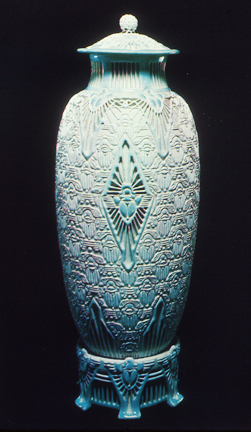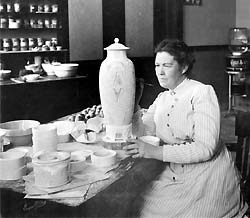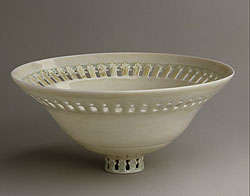|
|
1910. Porcelain, Museum purchase, P.C. 30.4.78 a-c. Everson Museum of Art, Syracuse, NY |
Adelaide Alsop Robineau was born in 1865 in Middletown, Connecticut. As a young woman she became interested in the hand-painted china which was a wildly popular hobby following the Centennial Exhibition in Philadelphia in 1876. To further her interest and skill as an artist, she studied painting with William Merritt Chase, the famed American impressionist. She married Samuel E. Robineau in 1899, and in that year the couple launched Keramic Studio, a pioneering periodical for ceramic artists and potters. Robineau became interested in the medium herself, studying under Charles Binns at Alfred University.
Robineau experimented with glazes and forms, influenced by the Arts and Crafts movement and its emphasis on quality materials, craftsmanship and simplicity of design. There are elements of Art Nouveau in the forms and stylized natural elements in her work as well. Rather than remain constrained by applying decoration to the blank forms made by others, she determined to create her own distinctly different porcelain forms.
Adelaide Robineau was an unusual woman for her day, having already established her national reputation as a china painter, publisher and artist by the time she began making her first ceramics in 1901. She was also the mother of three children, and taught on the staffs of both Syracuse University and the People's University of the American Woman's League. She is best known for The Scarab Vase, also known as the "Apotheosis of the Toiler".
|
Made by Adelaide Alsop Robineau (1865–1929) |
Robineau spent over 1000 hours carving this immense and stunning vase. The vase was created as part of a project to publicize the young People's University in 1910. The People's University in University City, near Jefferson, Missouri, had encouraged its staff to create "grand, public statements in clay". The Scarab Vase was Robineau's contribution to the program, and a year later it won the Grand Prize in pottery at the Turin International Exhibition.
The scarab beetle, the major motif of the vase, was sacred to the ancient Egyptians as a symbol of the cycle of day and night, life and death, and immortality. Also known as the dung beetle, the scarab pushes a ball of dung to close the entrance to its chamber each night. "As it emerges for the day, the ball of dung is pushed aside. This came to be a symbol of the emergence of the sun from the horizon as it rises each morning, and the setting of the sun as it disappears 'into the earth' each night. The title, 'The Apotheosis of the Toiler,' refers to all the unknown craftsmen of the world who labor on their craft, just as she had done in carving this piece. In a sense, her aim with this piece was to place the craftsman (or woman) in his (or her) proper place: to elevate craftspeople perhaps not to the status of a god, but to at least an equal to that of the artist."
|
On April 4, 1910, the first kiln of high fire porcelains was fired at the Art Academy of the People's University. The artists who gathered for a photograph include (left to right) Frederick H. Rhead, Samuel Robineau, Edward Gardner Lewis, Adelaide Alsop Robineau, Mabel Gertrude Lewis, Eugene Labarriere, George Julian Zolnay, Emile Diffloth and Taxile Doat. This photograph appeared in "The Woman's National Daily" on April 9, 1910. |
When the vase came out of the kiln, there were several small cracks in the work. Her teacher at that time, Taxile Doat, advised her to discard the work and begin again as it appeared irreparable. Instead, Robineau spent hours grinding bisque into a paste with powdered glaze, and filled the cracks. Then she reglazed and finished the piece. It emerged perfectly intact with no signs of the repairs.
Adelaide Robineau's influence on the American art pottery movement at the turn of the century was international in scope. She and her husband created a studio next to their home, called Four Winds, and she continued to teach on the staff of Syracuse University until her death in 1929. The home and studio that she built still stand on Robineau Road overlooking Onondaga Park and downtown Syracuse. The purchase of a large portion of her body of work in 1916 established the fledgling Everson Museum of Art in Syracuse as a leading exponent of modern ceramics as a fine art. Everson Museum
Art & Antiques Magazine in its March 2000 issue feature article, "Top Treasures of the Century," has designated Robineau's masterwork the most important piece of American ceramics of the last one-hundred years. By the time of her death in 1929, Robineau was widely recognized as the preeminent artist-potter in America, and the first to produce porcelain objects that rivaled those from European porcelain factories in both design and execution.



